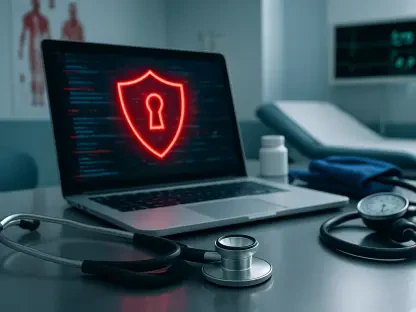In the contemporary world driven by technology, healthcare data breaches have become alarmingly frequent and complex, posing significant risks to both patients and healthcare providers. Between 2010 and the present year, there has been a staggering increase in compromised patient records, largely owing to hacking and IT incidents. These breaches represent an alarming trend and have evolved in both frequency and sophistication. With incidents multiplying yearly, primarily driven by ransomware attacks, the healthcare sector finds itself at a crucial juncture. As the number of records exposed continues to rise, so does the need for fortified cybersecurity strategies to combat this pervasive threat effectively.
The Rise in Healthcare Data Breaches
Early Trends and Influencing Factors
The number of healthcare data breaches has escalated considerably over the past 14 years, transitioning from 216 reported incidents in 2010 to a projected 566 by the present. This dramatic increase correlates closely with the rise in hacking and IT-related breaches, which surged from 4% of incidents in 2010 to a significant 81% currently. Such breaches predominantly involve sophisticated hacking techniques and specific IT incidents, including ransomware attacks. Ransomware particularly stands out, contributing to nearly 40% of compromised records over the period. By infiltrating systems and encrypting data, hackers demand ransom payments to restore access, creating havoc across healthcare facilities. Initially non-existent in 2010, ransomware attacks account for over 69% of breached patient records.
The Impact of Ransomware
Ransomware attacks’ impact on the healthcare industry is severe, with data encryption leading to operational disruptions and patient data vulnerability. The sector is especially susceptible due to often underdeveloped cybersecurity frameworks. One illustrative incident is the ransomware attack on Change Healthcare—owned by UnitedHealth—which caused extensive disruptions and was reported as the largest healthcare data breach to federal authorities. Such cases emphasize an urgent need for enhanced cybersecurity protocols. However, beyond the technological perspective, ransomware poses ethical and operational challenges, as healthcare providers weigh paying ransoms against compromising patient care and data integrity. This dilemma places further strain on healthcare institutions already grappling with complex operational demands.
The Implications of Increasing Data Breaches
Record Exposures and Operational Challenges
The number of exposed patient records due to data breaches has shown a disturbing upward trajectory. While only 6 million records were affected in 2010, that number has risen sharply to an estimated 170 million records currently. This surge primarily stems from hacking and IT incidents, which once contributed to just 2% of records exposed and now account for 91%. The increase in compromised data has escalated operational challenges for healthcare providers, undermining trust and complicating compliance with regulations. As the industry confronts these challenges, it must grapple with vulnerabilities within existing systems and anticipate potential threats from sophisticated cybercriminal techniques designed to exploit system weaknesses.
Recommendations for Mitigation
Addressing healthcare data breaches requires proactive and well-defined mitigation strategies. Implementing mandatory reporting of ransomware-related fields can significantly enhance surveillance accuracy, offering insights for healthcare organizations to develop counteractive measures. Revising severity classifications to incorporate the breach impact on operations and tracking cryptocurrency transactions to avert ransom payments are essential steps in this direction. Advanced monitoring technologies and educated personnel are crucial to identifying potential cyber threats early. As cyberattacks grow in intricacy, healthcare providers must prioritize resilience through continuous risk assessments, evolving their cybersecurity measures in tandem with emerging threats.
Adapting to the Evolving Threat Landscape
Need for Comprehensive Cybersecurity
Healthcare organizations must adapt swiftly to the evolving threat landscape, acknowledging the continuous rise in data breaches and the heightened sophistication of ransomware attacks. Comprehensive cybersecurity measures are paramount to safeguard patient data and maintain operational continuity. This involves strengthening IT infrastructure, investing in advanced encryption technologies, implementing access control measures, and fostering a culture of awareness among healthcare professionals. Moreover, simulating threat scenarios regularly and establishing protocols for data recovery and communication during breaches can prepare organizations for swift responses, minimizing damage and restoring trust among patients and stakeholders.
Collaboration and Policy Initiatives
To effectively address the burgeoning cyber threat landscape, collaboration among healthcare providers, policymakers, and cybersecurity experts is crucial. Developing industry-wide standards and guidelines can facilitate a cohesive response to these threats, fostering a unified defense mechanism across the sector. Policymakers must advocate for rigorous cybersecurity regulations, promoting investment in state-of-the-art technologies and training for healthcare professionals. Encouraging information sharing about potential threats and breach experiences can create a collaborative environment conducive to innovation in cybersecurity practices. By uniting efforts, the healthcare sector can fortify its defenses, ensuring resilience against future cyber incidents and safeguarding sensitive patient information.
The Path Forward
In today’s tech-driven era, the frequency and complexity of healthcare data breaches have surged alarmingly, presenting considerable risks to both patients and healthcare providers. From 2010 to now, there has been a dramatic increase in the number of compromised patient records, chiefly due to hacking and IT-related incidents. This troubling trend reveals an evolution not just in the volume but also in the sophistication of such breaches. Annually, these incidents proliferate, largely fueled by ransomware attacks, putting the healthcare sector at a pivotal crossroads. The increasing volume of exposed patient records underscores an urgent call for enhanced cybersecurity measures. Effective strategies are crucial to safeguard sensitive data and protect against this growing threat. As healthcare entities grapple with these challenges, bolstering defenses is essential to safeguard patient trust and maintain the integrity of medical records. It is imperative for healthcare professionals to prioritize cybersecurity to counteract this pervasive issue as it continues to evolve.









